Exploring Leadership Styles in 'Remember the Titans'
VerifiedAdded on 2020/05/11
|10
|2881
|635
AI Summary
In this assignment, you're tasked with exploring leadership styles in 'Remember the Titans'. Focus on identifying and analyzing different types, particularly transformational and transactional leadership as exhibited by the coaches Boone and Yoast. Evaluate how these styles affect the players' performance and morale. Finally, conclude which leadership style was most effective in motivating and uniting the team during their challenging journey.
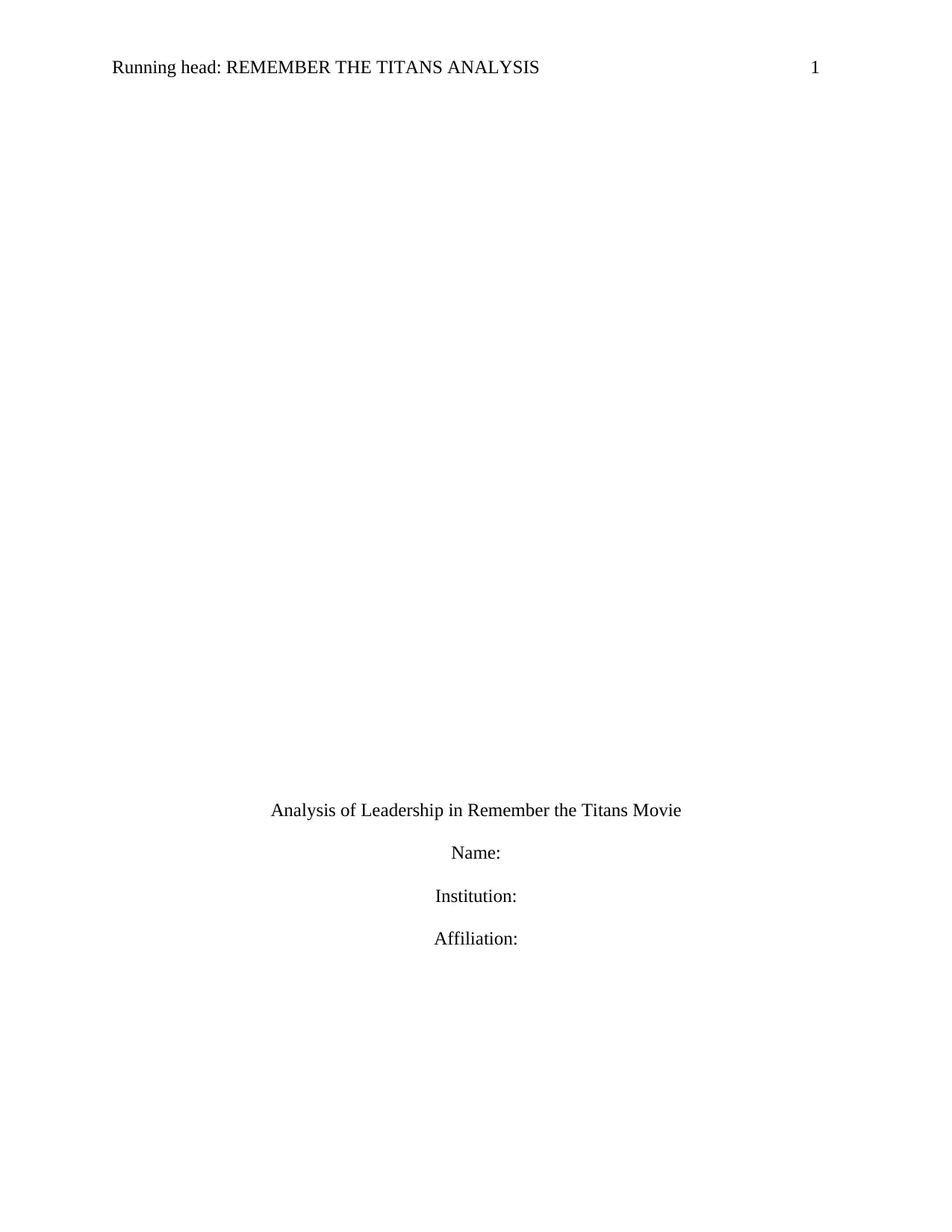
Running head: REMEMBER THE TITANS ANALYSIS 1
Analysis of Leadership in Remember the Titans Movie
Name:
Institution:
Affiliation:
Analysis of Leadership in Remember the Titans Movie
Name:
Institution:
Affiliation:
Paraphrase This Document
Need a fresh take? Get an instant paraphrase of this document with our AI Paraphraser
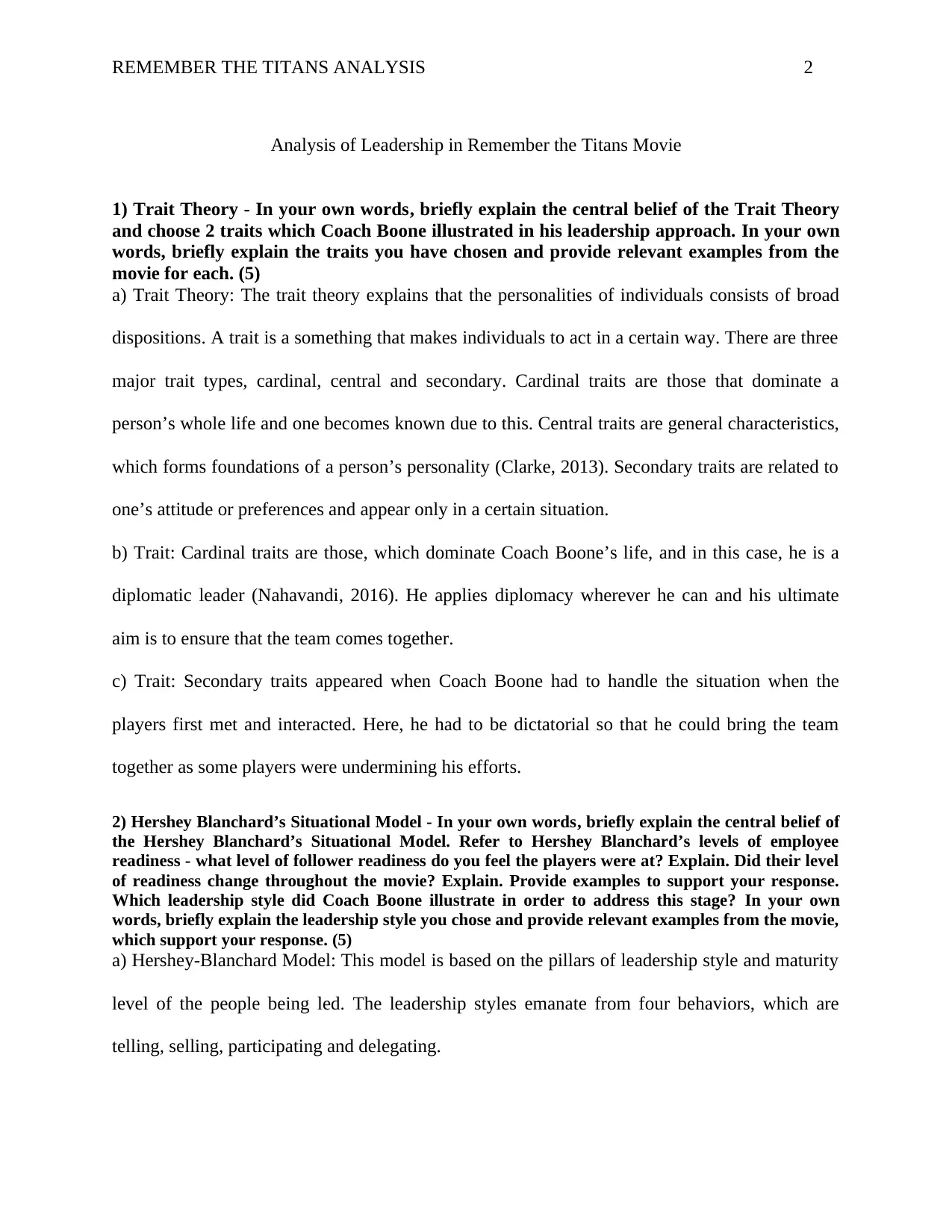
REMEMBER THE TITANS ANALYSIS 2
Analysis of Leadership in Remember the Titans Movie
1) Trait Theory - In your own words, briefly explain the central belief of the Trait Theory
and choose 2 traits which Coach Boone illustrated in his leadership approach. In your own
words, briefly explain the traits you have chosen and provide relevant examples from the
movie for each. (5)
a) Trait Theory: The trait theory explains that the personalities of individuals consists of broad
dispositions. A trait is a something that makes individuals to act in a certain way. There are three
major trait types, cardinal, central and secondary. Cardinal traits are those that dominate a
person’s whole life and one becomes known due to this. Central traits are general characteristics,
which forms foundations of a person’s personality (Clarke, 2013). Secondary traits are related to
one’s attitude or preferences and appear only in a certain situation.
b) Trait: Cardinal traits are those, which dominate Coach Boone’s life, and in this case, he is a
diplomatic leader (Nahavandi, 2016). He applies diplomacy wherever he can and his ultimate
aim is to ensure that the team comes together.
c) Trait: Secondary traits appeared when Coach Boone had to handle the situation when the
players first met and interacted. Here, he had to be dictatorial so that he could bring the team
together as some players were undermining his efforts.
2) Hershey Blanchard’s Situational Model - In your own words, briefly explain the central belief of
the Hershey Blanchard’s Situational Model. Refer to Hershey Blanchard’s levels of employee
readiness - what level of follower readiness do you feel the players were at? Explain. Did their level
of readiness change throughout the movie? Explain. Provide examples to support your response.
Which leadership style did Coach Boone illustrate in order to address this stage? In your own
words, briefly explain the leadership style you chose and provide relevant examples from the movie,
which support your response. (5)
a) Hershey-Blanchard Model: This model is based on the pillars of leadership style and maturity
level of the people being led. The leadership styles emanate from four behaviors, which are
telling, selling, participating and delegating.
Analysis of Leadership in Remember the Titans Movie
1) Trait Theory - In your own words, briefly explain the central belief of the Trait Theory
and choose 2 traits which Coach Boone illustrated in his leadership approach. In your own
words, briefly explain the traits you have chosen and provide relevant examples from the
movie for each. (5)
a) Trait Theory: The trait theory explains that the personalities of individuals consists of broad
dispositions. A trait is a something that makes individuals to act in a certain way. There are three
major trait types, cardinal, central and secondary. Cardinal traits are those that dominate a
person’s whole life and one becomes known due to this. Central traits are general characteristics,
which forms foundations of a person’s personality (Clarke, 2013). Secondary traits are related to
one’s attitude or preferences and appear only in a certain situation.
b) Trait: Cardinal traits are those, which dominate Coach Boone’s life, and in this case, he is a
diplomatic leader (Nahavandi, 2016). He applies diplomacy wherever he can and his ultimate
aim is to ensure that the team comes together.
c) Trait: Secondary traits appeared when Coach Boone had to handle the situation when the
players first met and interacted. Here, he had to be dictatorial so that he could bring the team
together as some players were undermining his efforts.
2) Hershey Blanchard’s Situational Model - In your own words, briefly explain the central belief of
the Hershey Blanchard’s Situational Model. Refer to Hershey Blanchard’s levels of employee
readiness - what level of follower readiness do you feel the players were at? Explain. Did their level
of readiness change throughout the movie? Explain. Provide examples to support your response.
Which leadership style did Coach Boone illustrate in order to address this stage? In your own
words, briefly explain the leadership style you chose and provide relevant examples from the movie,
which support your response. (5)
a) Hershey-Blanchard Model: This model is based on the pillars of leadership style and maturity
level of the people being led. The leadership styles emanate from four behaviors, which are
telling, selling, participating and delegating.
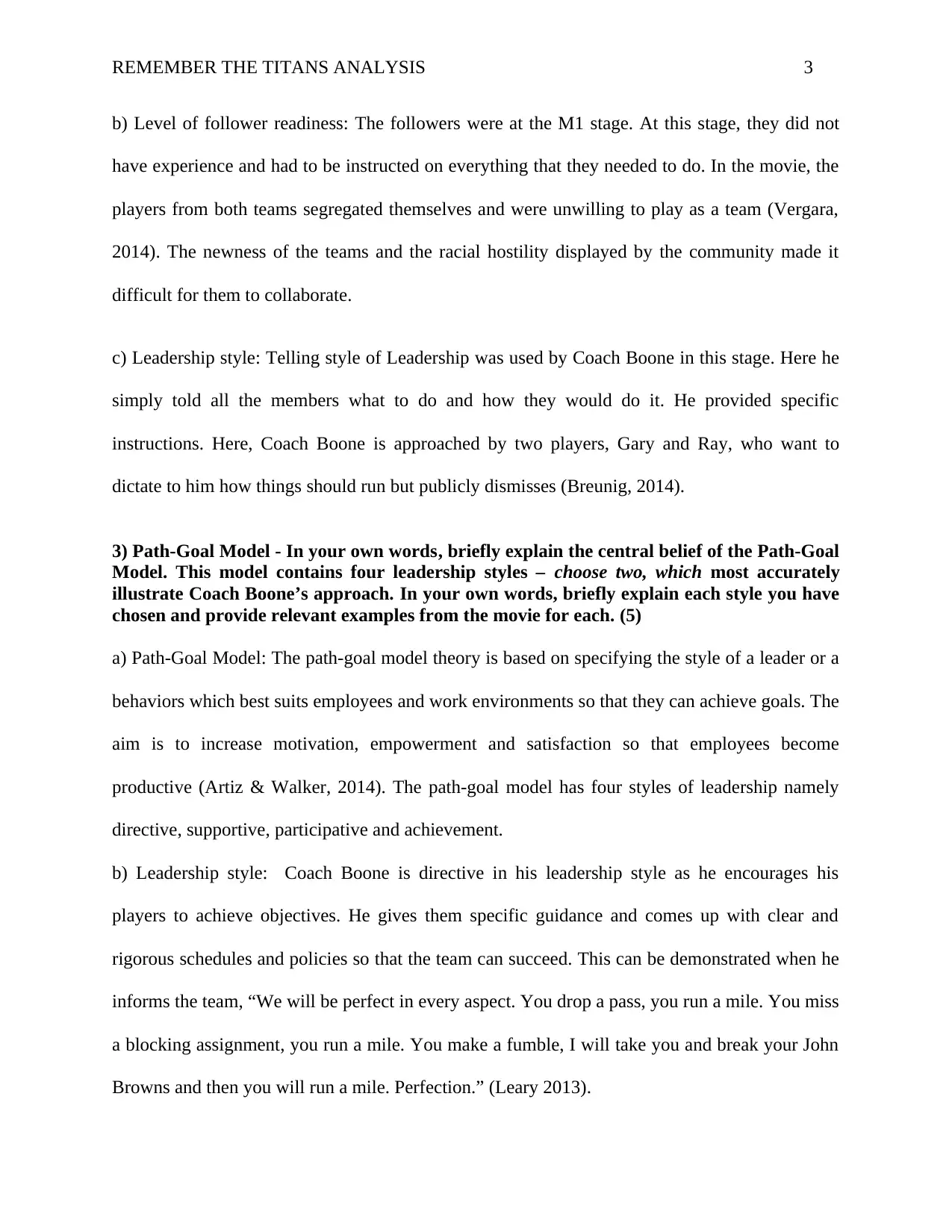
REMEMBER THE TITANS ANALYSIS 3
b) Level of follower readiness: The followers were at the M1 stage. At this stage, they did not
have experience and had to be instructed on everything that they needed to do. In the movie, the
players from both teams segregated themselves and were unwilling to play as a team (Vergara,
2014). The newness of the teams and the racial hostility displayed by the community made it
difficult for them to collaborate.
c) Leadership style: Telling style of Leadership was used by Coach Boone in this stage. Here he
simply told all the members what to do and how they would do it. He provided specific
instructions. Here, Coach Boone is approached by two players, Gary and Ray, who want to
dictate to him how things should run but publicly dismisses (Breunig, 2014).
3) Path-Goal Model - In your own words, briefly explain the central belief of the Path-Goal
Model. This model contains four leadership styles – choose two, which most accurately
illustrate Coach Boone’s approach. In your own words, briefly explain each style you have
chosen and provide relevant examples from the movie for each. (5)
a) Path-Goal Model: The path-goal model theory is based on specifying the style of a leader or a
behaviors which best suits employees and work environments so that they can achieve goals. The
aim is to increase motivation, empowerment and satisfaction so that employees become
productive (Artiz & Walker, 2014). The path-goal model has four styles of leadership namely
directive, supportive, participative and achievement.
b) Leadership style: Coach Boone is directive in his leadership style as he encourages his
players to achieve objectives. He gives them specific guidance and comes up with clear and
rigorous schedules and policies so that the team can succeed. This can be demonstrated when he
informs the team, “We will be perfect in every aspect. You drop a pass, you run a mile. You miss
a blocking assignment, you run a mile. You make a fumble, I will take you and break your John
Browns and then you will run a mile. Perfection.” (Leary 2013).
b) Level of follower readiness: The followers were at the M1 stage. At this stage, they did not
have experience and had to be instructed on everything that they needed to do. In the movie, the
players from both teams segregated themselves and were unwilling to play as a team (Vergara,
2014). The newness of the teams and the racial hostility displayed by the community made it
difficult for them to collaborate.
c) Leadership style: Telling style of Leadership was used by Coach Boone in this stage. Here he
simply told all the members what to do and how they would do it. He provided specific
instructions. Here, Coach Boone is approached by two players, Gary and Ray, who want to
dictate to him how things should run but publicly dismisses (Breunig, 2014).
3) Path-Goal Model - In your own words, briefly explain the central belief of the Path-Goal
Model. This model contains four leadership styles – choose two, which most accurately
illustrate Coach Boone’s approach. In your own words, briefly explain each style you have
chosen and provide relevant examples from the movie for each. (5)
a) Path-Goal Model: The path-goal model theory is based on specifying the style of a leader or a
behaviors which best suits employees and work environments so that they can achieve goals. The
aim is to increase motivation, empowerment and satisfaction so that employees become
productive (Artiz & Walker, 2014). The path-goal model has four styles of leadership namely
directive, supportive, participative and achievement.
b) Leadership style: Coach Boone is directive in his leadership style as he encourages his
players to achieve objectives. He gives them specific guidance and comes up with clear and
rigorous schedules and policies so that the team can succeed. This can be demonstrated when he
informs the team, “We will be perfect in every aspect. You drop a pass, you run a mile. You miss
a blocking assignment, you run a mile. You make a fumble, I will take you and break your John
Browns and then you will run a mile. Perfection.” (Leary 2013).
⊘ This is a preview!⊘
Do you want full access?
Subscribe today to unlock all pages.

Trusted by 1+ million students worldwide
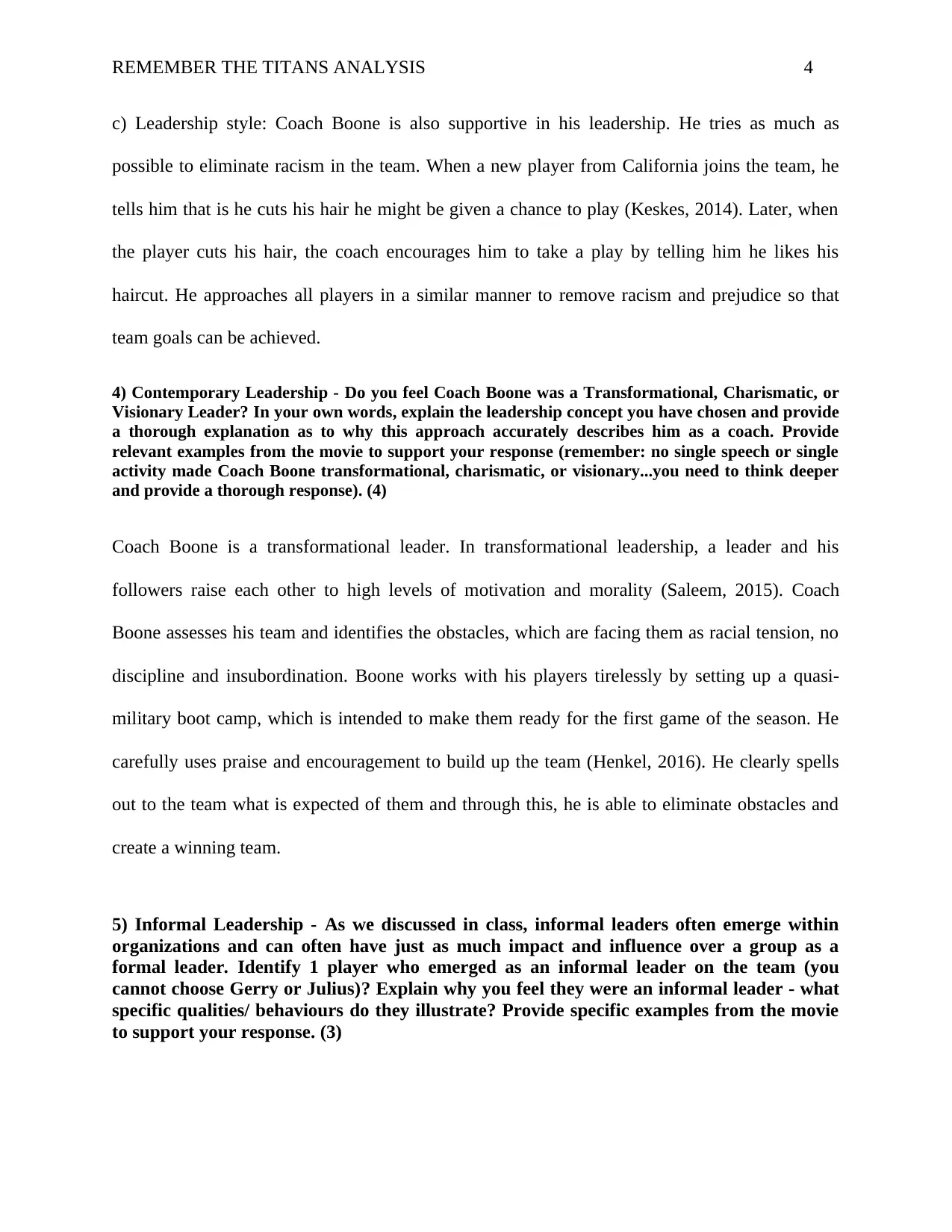
REMEMBER THE TITANS ANALYSIS 4
c) Leadership style: Coach Boone is also supportive in his leadership. He tries as much as
possible to eliminate racism in the team. When a new player from California joins the team, he
tells him that is he cuts his hair he might be given a chance to play (Keskes, 2014). Later, when
the player cuts his hair, the coach encourages him to take a play by telling him he likes his
haircut. He approaches all players in a similar manner to remove racism and prejudice so that
team goals can be achieved.
4) Contemporary Leadership - Do you feel Coach Boone was a Transformational, Charismatic, or
Visionary Leader? In your own words, explain the leadership concept you have chosen and provide
a thorough explanation as to why this approach accurately describes him as a coach. Provide
relevant examples from the movie to support your response (remember: no single speech or single
activity made Coach Boone transformational, charismatic, or visionary...you need to think deeper
and provide a thorough response). (4)
Coach Boone is a transformational leader. In transformational leadership, a leader and his
followers raise each other to high levels of motivation and morality (Saleem, 2015). Coach
Boone assesses his team and identifies the obstacles, which are facing them as racial tension, no
discipline and insubordination. Boone works with his players tirelessly by setting up a quasi-
military boot camp, which is intended to make them ready for the first game of the season. He
carefully uses praise and encouragement to build up the team (Henkel, 2016). He clearly spells
out to the team what is expected of them and through this, he is able to eliminate obstacles and
create a winning team.
5) Informal Leadership - As we discussed in class, informal leaders often emerge within
organizations and can often have just as much impact and influence over a group as a
formal leader. Identify 1 player who emerged as an informal leader on the team (you
cannot choose Gerry or Julius)? Explain why you feel they were an informal leader - what
specific qualities/ behaviours do they illustrate? Provide specific examples from the movie
to support your response. (3)
c) Leadership style: Coach Boone is also supportive in his leadership. He tries as much as
possible to eliminate racism in the team. When a new player from California joins the team, he
tells him that is he cuts his hair he might be given a chance to play (Keskes, 2014). Later, when
the player cuts his hair, the coach encourages him to take a play by telling him he likes his
haircut. He approaches all players in a similar manner to remove racism and prejudice so that
team goals can be achieved.
4) Contemporary Leadership - Do you feel Coach Boone was a Transformational, Charismatic, or
Visionary Leader? In your own words, explain the leadership concept you have chosen and provide
a thorough explanation as to why this approach accurately describes him as a coach. Provide
relevant examples from the movie to support your response (remember: no single speech or single
activity made Coach Boone transformational, charismatic, or visionary...you need to think deeper
and provide a thorough response). (4)
Coach Boone is a transformational leader. In transformational leadership, a leader and his
followers raise each other to high levels of motivation and morality (Saleem, 2015). Coach
Boone assesses his team and identifies the obstacles, which are facing them as racial tension, no
discipline and insubordination. Boone works with his players tirelessly by setting up a quasi-
military boot camp, which is intended to make them ready for the first game of the season. He
carefully uses praise and encouragement to build up the team (Henkel, 2016). He clearly spells
out to the team what is expected of them and through this, he is able to eliminate obstacles and
create a winning team.
5) Informal Leadership - As we discussed in class, informal leaders often emerge within
organizations and can often have just as much impact and influence over a group as a
formal leader. Identify 1 player who emerged as an informal leader on the team (you
cannot choose Gerry or Julius)? Explain why you feel they were an informal leader - what
specific qualities/ behaviours do they illustrate? Provide specific examples from the movie
to support your response. (3)
Paraphrase This Document
Need a fresh take? Get an instant paraphrase of this document with our AI Paraphraser

REMEMBER THE TITANS ANALYSIS 5
Informal leadership is one’s ability to influence behavior of others by means, which do not
involve formal authority. Such leaders can display informal and formal power. Informal leaders
do not have the official authority to lead but they influence their fellow team members and can
be more effective than the formal leaders in certain situations. One of the informal leaders in
remember the titans is Louis Lastik. He was not judgmental based on skin color. This made him
very reliable (Suen et al, 2016). When Louis walks into the lunchroom, he sits with the African
Americans and his teammates regard him as a traitor. The African Americans also ask him what
he is doing and tell him to go and sit with his people. Despite this, he replies that he does not
have any people and that he is with everybody. This behavior portrays what Coach Boone wants
to see among his teammates (Cooper, 2016). It influences others in the team to see that they can
interact freely and there is no need for racial segregation as their ultimate aim is to see the team
succeed.
6) Servant-Oriented Leadership - Coach Boone was extremely hard on his players however, despite
his seemingly cruel approach, you could see he cared for them very much and he supported them in
many ways. In your own words, explain the concept of Servant-Oriented Leadership, and provide 2
examples from the movie, which illustrate how Coach Boone was a Servant-Oriented Leader.
Explain the significance of your examples. (3)
a) Servant-Oriented Leadership: This is the type of leadership whereby the leader is servant first.
The leader has the desire of serving his followers and wants to help those (Sarver & Miller,
2014). It is related to meeting the needs of colleagues and communities.
b) Example: Coach Boone demonstrates servant leadership by helping his team progress towards
success by clarifying their paths. He instills in the team the notion that working hard will lead to
good performance, which will be recognized and rewarded. Coach Boone goes to the extent of
waking up the team at odd hours to practice so that they succeed in their games.
Informal leadership is one’s ability to influence behavior of others by means, which do not
involve formal authority. Such leaders can display informal and formal power. Informal leaders
do not have the official authority to lead but they influence their fellow team members and can
be more effective than the formal leaders in certain situations. One of the informal leaders in
remember the titans is Louis Lastik. He was not judgmental based on skin color. This made him
very reliable (Suen et al, 2016). When Louis walks into the lunchroom, he sits with the African
Americans and his teammates regard him as a traitor. The African Americans also ask him what
he is doing and tell him to go and sit with his people. Despite this, he replies that he does not
have any people and that he is with everybody. This behavior portrays what Coach Boone wants
to see among his teammates (Cooper, 2016). It influences others in the team to see that they can
interact freely and there is no need for racial segregation as their ultimate aim is to see the team
succeed.
6) Servant-Oriented Leadership - Coach Boone was extremely hard on his players however, despite
his seemingly cruel approach, you could see he cared for them very much and he supported them in
many ways. In your own words, explain the concept of Servant-Oriented Leadership, and provide 2
examples from the movie, which illustrate how Coach Boone was a Servant-Oriented Leader.
Explain the significance of your examples. (3)
a) Servant-Oriented Leadership: This is the type of leadership whereby the leader is servant first.
The leader has the desire of serving his followers and wants to help those (Sarver & Miller,
2014). It is related to meeting the needs of colleagues and communities.
b) Example: Coach Boone demonstrates servant leadership by helping his team progress towards
success by clarifying their paths. He instills in the team the notion that working hard will lead to
good performance, which will be recognized and rewarded. Coach Boone goes to the extent of
waking up the team at odd hours to practice so that they succeed in their games.

REMEMBER THE TITANS ANALYSIS 6
c) Example: Coach Boone’s servant leadership is shown by his efforts of bringing the team
together despite the racial segregation (Gopal & Chowdhury, 2014). He considers racial
segregation as a key obstacle to team success and does all he can to ensure that the team gels
together.
7) Team Chemistry - A key function of a leader is to create an environment in which people
can work together effectively. This requires collaboration, cooperation, support, and
chemistry among members. Identify 2 methods Coach Boone used in order to create team
chemistry and help move the players from being ‘individuals’ to becoming ‘team players’.
Explain the significance of your examples. (4)
a) Coach Boone builds personal connections between the team players. He wakes up the team to
have a run at 3 a.m. and stops when they arrive at the Gettysburg Cemetery, which has fallen
soldiers buried in its grounds (McCleskey, 2014). He then gives a speech about coming together of
the team by telling them, “If we don't come together right now on this hallowed ground, we too
will be destroyed, just like they were. I don't care if you like each other of not, but you will
respect each other (Leary, 2013).” He then comes up with a strategy where a black player must
have a white player as a roommate and they must get to know one another and present what they
have learned about their new teammate (Bellamy & Bellamy, 2016).
b) Coach Boone ensures that there is strong internal leadership. This is an essential aspect for
any team to succeed. He allows Garry and Julius to make team decisions and this makes the team
stronger and more cohesive (Holmes, 2016). He also is not afraid to make changes on the field
during games and this leads to overall team success for the titans.
8) Boone VS Yoast - Coach Boone and Coach Yoast both had very different approaches in
regards to their leadership style. In your opinion, whose approach do you prefer and feel
was more effective? Of the two coaches, whose leadership style would you like to
incorporate into your own practice? Explain. (3)
c) Example: Coach Boone’s servant leadership is shown by his efforts of bringing the team
together despite the racial segregation (Gopal & Chowdhury, 2014). He considers racial
segregation as a key obstacle to team success and does all he can to ensure that the team gels
together.
7) Team Chemistry - A key function of a leader is to create an environment in which people
can work together effectively. This requires collaboration, cooperation, support, and
chemistry among members. Identify 2 methods Coach Boone used in order to create team
chemistry and help move the players from being ‘individuals’ to becoming ‘team players’.
Explain the significance of your examples. (4)
a) Coach Boone builds personal connections between the team players. He wakes up the team to
have a run at 3 a.m. and stops when they arrive at the Gettysburg Cemetery, which has fallen
soldiers buried in its grounds (McCleskey, 2014). He then gives a speech about coming together of
the team by telling them, “If we don't come together right now on this hallowed ground, we too
will be destroyed, just like they were. I don't care if you like each other of not, but you will
respect each other (Leary, 2013).” He then comes up with a strategy where a black player must
have a white player as a roommate and they must get to know one another and present what they
have learned about their new teammate (Bellamy & Bellamy, 2016).
b) Coach Boone ensures that there is strong internal leadership. This is an essential aspect for
any team to succeed. He allows Garry and Julius to make team decisions and this makes the team
stronger and more cohesive (Holmes, 2016). He also is not afraid to make changes on the field
during games and this leads to overall team success for the titans.
8) Boone VS Yoast - Coach Boone and Coach Yoast both had very different approaches in
regards to their leadership style. In your opinion, whose approach do you prefer and feel
was more effective? Of the two coaches, whose leadership style would you like to
incorporate into your own practice? Explain. (3)
⊘ This is a preview!⊘
Do you want full access?
Subscribe today to unlock all pages.

Trusted by 1+ million students worldwide
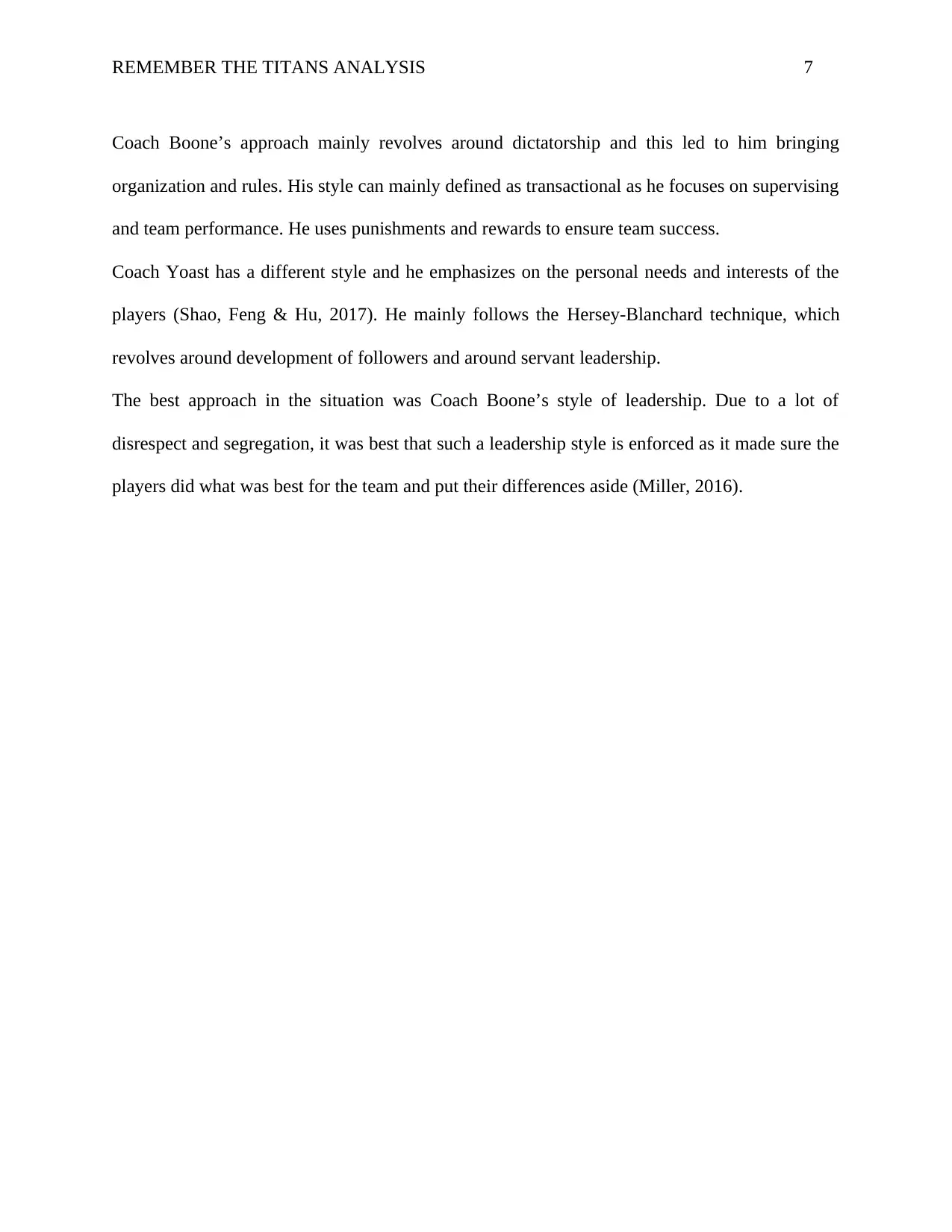
REMEMBER THE TITANS ANALYSIS 7
Coach Boone’s approach mainly revolves around dictatorship and this led to him bringing
organization and rules. His style can mainly defined as transactional as he focuses on supervising
and team performance. He uses punishments and rewards to ensure team success.
Coach Yoast has a different style and he emphasizes on the personal needs and interests of the
players (Shao, Feng & Hu, 2017). He mainly follows the Hersey-Blanchard technique, which
revolves around development of followers and around servant leadership.
The best approach in the situation was Coach Boone’s style of leadership. Due to a lot of
disrespect and segregation, it was best that such a leadership style is enforced as it made sure the
players did what was best for the team and put their differences aside (Miller, 2016).
Coach Boone’s approach mainly revolves around dictatorship and this led to him bringing
organization and rules. His style can mainly defined as transactional as he focuses on supervising
and team performance. He uses punishments and rewards to ensure team success.
Coach Yoast has a different style and he emphasizes on the personal needs and interests of the
players (Shao, Feng & Hu, 2017). He mainly follows the Hersey-Blanchard technique, which
revolves around development of followers and around servant leadership.
The best approach in the situation was Coach Boone’s style of leadership. Due to a lot of
disrespect and segregation, it was best that such a leadership style is enforced as it made sure the
players did what was best for the team and put their differences aside (Miller, 2016).
Paraphrase This Document
Need a fresh take? Get an instant paraphrase of this document with our AI Paraphraser
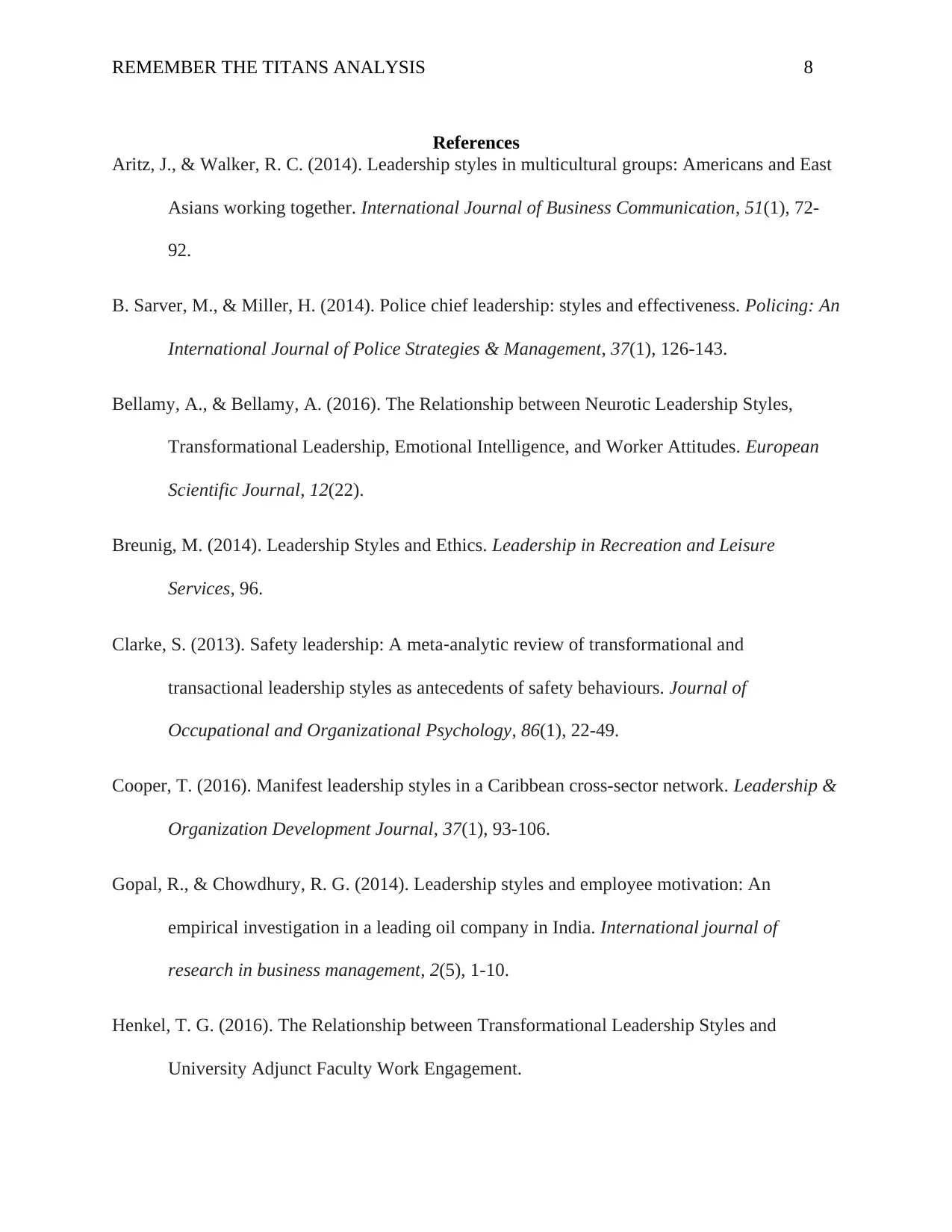
REMEMBER THE TITANS ANALYSIS 8
References
Aritz, J., & Walker, R. C. (2014). Leadership styles in multicultural groups: Americans and East
Asians working together. International Journal of Business Communication, 51(1), 72-
92.
B. Sarver, M., & Miller, H. (2014). Police chief leadership: styles and effectiveness. Policing: An
International Journal of Police Strategies & Management, 37(1), 126-143.
Bellamy, A., & Bellamy, A. (2016). The Relationship between Neurotic Leadership Styles,
Transformational Leadership, Emotional Intelligence, and Worker Attitudes. European
Scientific Journal, 12(22).
Breunig, M. (2014). Leadership Styles and Ethics. Leadership in Recreation and Leisure
Services, 96.
Clarke, S. (2013). Safety leadership: A meta‐analytic review of transformational and
transactional leadership styles as antecedents of safety behaviours. Journal of
Occupational and Organizational Psychology, 86(1), 22-49.
Cooper, T. (2016). Manifest leadership styles in a Caribbean cross-sector network. Leadership &
Organization Development Journal, 37(1), 93-106.
Gopal, R., & Chowdhury, R. G. (2014). Leadership styles and employee motivation: An
empirical investigation in a leading oil company in India. International journal of
research in business management, 2(5), 1-10.
Henkel, T. G. (2016). The Relationship between Transformational Leadership Styles and
University Adjunct Faculty Work Engagement.
References
Aritz, J., & Walker, R. C. (2014). Leadership styles in multicultural groups: Americans and East
Asians working together. International Journal of Business Communication, 51(1), 72-
92.
B. Sarver, M., & Miller, H. (2014). Police chief leadership: styles and effectiveness. Policing: An
International Journal of Police Strategies & Management, 37(1), 126-143.
Bellamy, A., & Bellamy, A. (2016). The Relationship between Neurotic Leadership Styles,
Transformational Leadership, Emotional Intelligence, and Worker Attitudes. European
Scientific Journal, 12(22).
Breunig, M. (2014). Leadership Styles and Ethics. Leadership in Recreation and Leisure
Services, 96.
Clarke, S. (2013). Safety leadership: A meta‐analytic review of transformational and
transactional leadership styles as antecedents of safety behaviours. Journal of
Occupational and Organizational Psychology, 86(1), 22-49.
Cooper, T. (2016). Manifest leadership styles in a Caribbean cross-sector network. Leadership &
Organization Development Journal, 37(1), 93-106.
Gopal, R., & Chowdhury, R. G. (2014). Leadership styles and employee motivation: An
empirical investigation in a leading oil company in India. International journal of
research in business management, 2(5), 1-10.
Henkel, T. G. (2016). The Relationship between Transformational Leadership Styles and
University Adjunct Faculty Work Engagement.
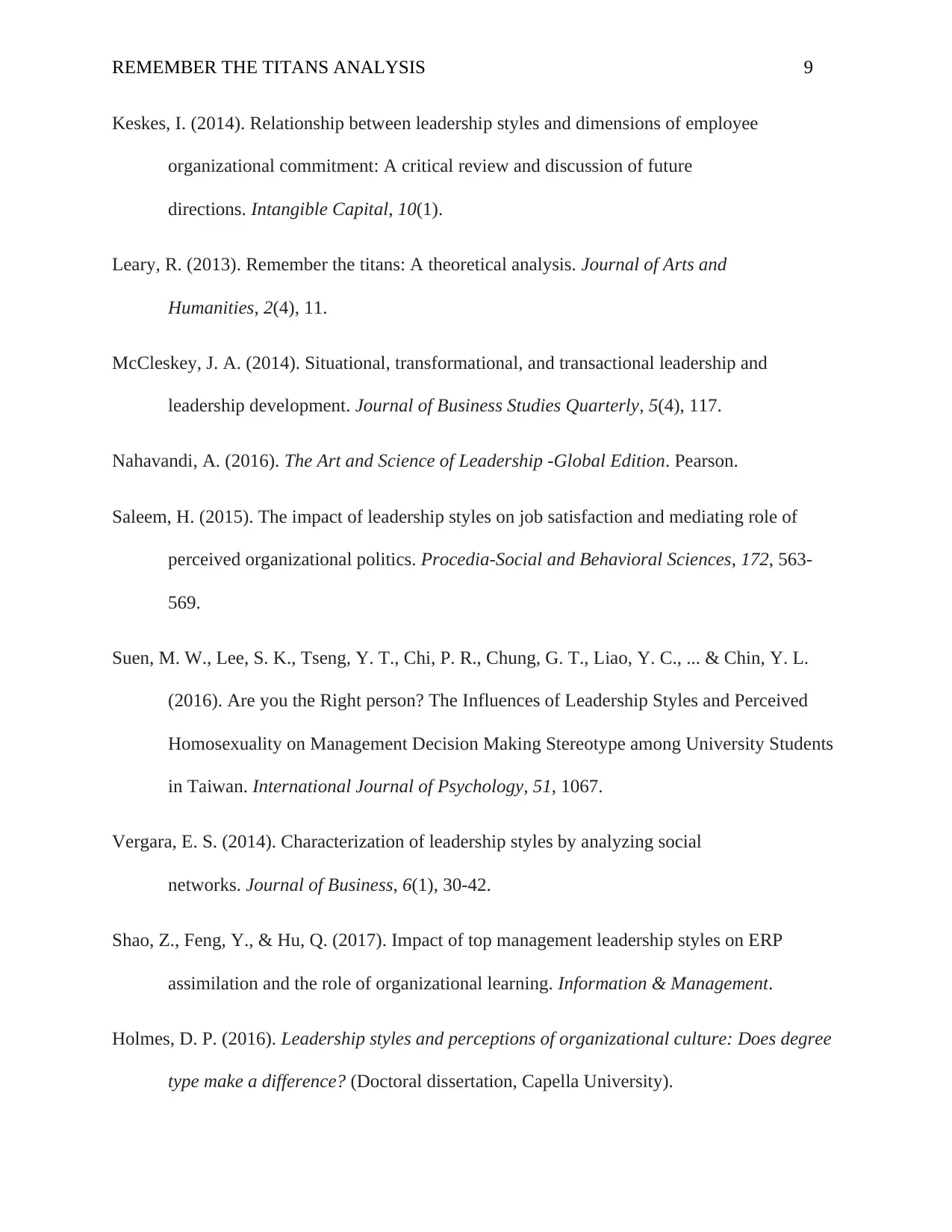
REMEMBER THE TITANS ANALYSIS 9
Keskes, I. (2014). Relationship between leadership styles and dimensions of employee
organizational commitment: A critical review and discussion of future
directions. Intangible Capital, 10(1).
Leary, R. (2013). Remember the titans: A theoretical analysis. Journal of Arts and
Humanities, 2(4), 11.
McCleskey, J. A. (2014). Situational, transformational, and transactional leadership and
leadership development. Journal of Business Studies Quarterly, 5(4), 117.
Nahavandi, A. (2016). The Art and Science of Leadership -Global Edition. Pearson.
Saleem, H. (2015). The impact of leadership styles on job satisfaction and mediating role of
perceived organizational politics. Procedia-Social and Behavioral Sciences, 172, 563-
569.
Suen, M. W., Lee, S. K., Tseng, Y. T., Chi, P. R., Chung, G. T., Liao, Y. C., ... & Chin, Y. L.
(2016). Are you the Right person? The Influences of Leadership Styles and Perceived
Homosexuality on Management Decision Making Stereotype among University Students
in Taiwan. International Journal of Psychology, 51, 1067.
Vergara, E. S. (2014). Characterization of leadership styles by analyzing social
networks. Journal of Business, 6(1), 30-42.
Shao, Z., Feng, Y., & Hu, Q. (2017). Impact of top management leadership styles on ERP
assimilation and the role of organizational learning. Information & Management.
Holmes, D. P. (2016). Leadership styles and perceptions of organizational culture: Does degree
type make a difference? (Doctoral dissertation, Capella University).
Keskes, I. (2014). Relationship between leadership styles and dimensions of employee
organizational commitment: A critical review and discussion of future
directions. Intangible Capital, 10(1).
Leary, R. (2013). Remember the titans: A theoretical analysis. Journal of Arts and
Humanities, 2(4), 11.
McCleskey, J. A. (2014). Situational, transformational, and transactional leadership and
leadership development. Journal of Business Studies Quarterly, 5(4), 117.
Nahavandi, A. (2016). The Art and Science of Leadership -Global Edition. Pearson.
Saleem, H. (2015). The impact of leadership styles on job satisfaction and mediating role of
perceived organizational politics. Procedia-Social and Behavioral Sciences, 172, 563-
569.
Suen, M. W., Lee, S. K., Tseng, Y. T., Chi, P. R., Chung, G. T., Liao, Y. C., ... & Chin, Y. L.
(2016). Are you the Right person? The Influences of Leadership Styles and Perceived
Homosexuality on Management Decision Making Stereotype among University Students
in Taiwan. International Journal of Psychology, 51, 1067.
Vergara, E. S. (2014). Characterization of leadership styles by analyzing social
networks. Journal of Business, 6(1), 30-42.
Shao, Z., Feng, Y., & Hu, Q. (2017). Impact of top management leadership styles on ERP
assimilation and the role of organizational learning. Information & Management.
Holmes, D. P. (2016). Leadership styles and perceptions of organizational culture: Does degree
type make a difference? (Doctoral dissertation, Capella University).
⊘ This is a preview!⊘
Do you want full access?
Subscribe today to unlock all pages.

Trusted by 1+ million students worldwide
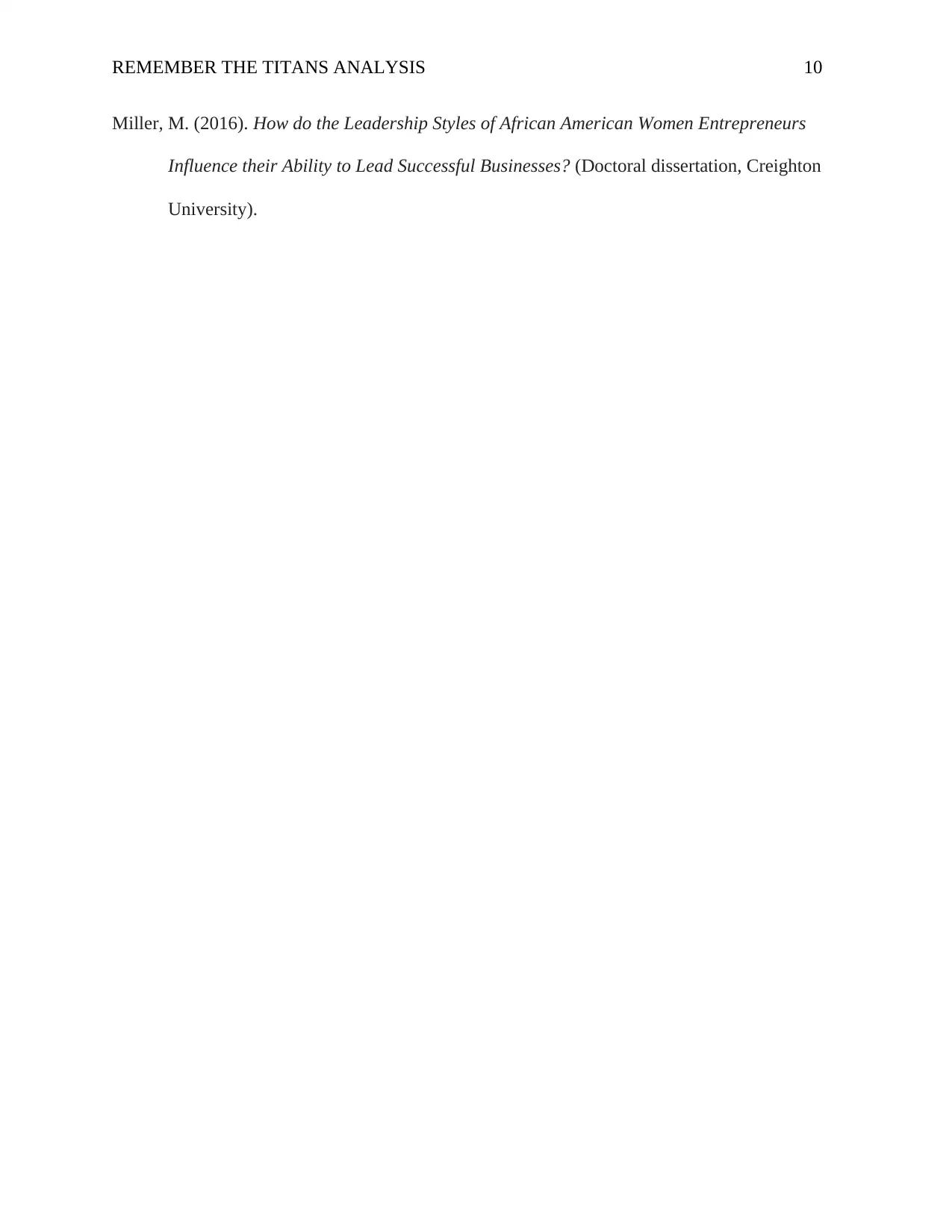
REMEMBER THE TITANS ANALYSIS 10
Miller, M. (2016). How do the Leadership Styles of African American Women Entrepreneurs
Influence their Ability to Lead Successful Businesses? (Doctoral dissertation, Creighton
University).
Miller, M. (2016). How do the Leadership Styles of African American Women Entrepreneurs
Influence their Ability to Lead Successful Businesses? (Doctoral dissertation, Creighton
University).
1 out of 10
Your All-in-One AI-Powered Toolkit for Academic Success.
+13062052269
info@desklib.com
Available 24*7 on WhatsApp / Email
![[object Object]](/_next/static/media/star-bottom.7253800d.svg)
Unlock your academic potential
Copyright © 2020–2025 A2Z Services. All Rights Reserved. Developed and managed by ZUCOL.